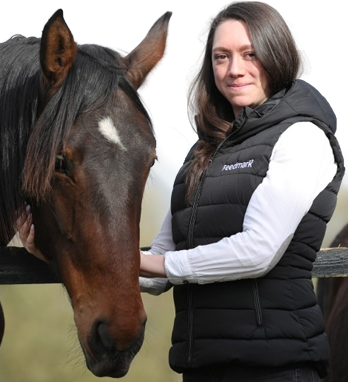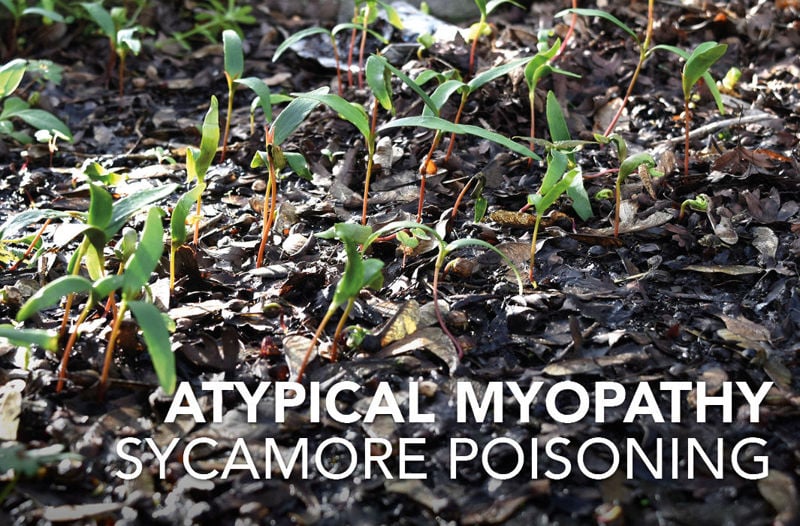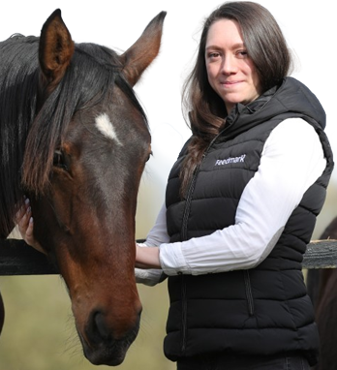Spring sees flora and fauna blossom into life which is a welcome sight after a long, wet winter, but it can also bring unwanted plants into our horse’s paddocks, one of those being sycamore seeds and seedlings. Sycamores drop their seeds, also known as ‘helicopter’ seeds, which can travel many miles from the tree into neighbouring paddocks. Once on the ground, these seeds can either be eaten by our horses, or germinate into the soil and eventually develop into seedlings. Unfortunately, both the seeds and seedlings (and even the leaves of the sycamore tree) contain a poison which can be very harmful, even fatal to horses, causing what is known as Atypical myopathy.
What is Atypical myopathy?
Atypical myopathy is a severe and often fatal muscle disorder caused by the ingestion of sycamore ‘helicopter’ seeds, seedlings and to a lesser degree the leaves of the sycamore tree (Bates, 2022).
Research has shown that Atypical myopathyonly affects grazing horses (Votion et al. 2020) and is most commonly seen during autumn but does occur during other seasons (González-Medina et al. 2017) and this year we have seen a record number of Sycamore seedlings in pastures and gardens compared to previous years.
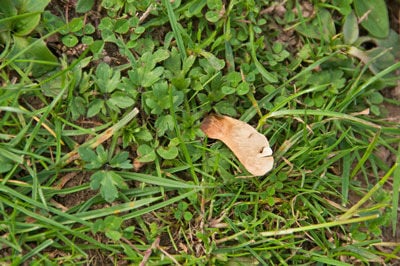
Sycamore seeds fall in autumn but many are still present or have seeded this spring
Sycamore seeds, seedlings and leaves contain Hypoglycin A (HGA), a toxin which, when ingested, is metabolised into compounds that slow or stop energy production in muscle cells. This particularly affects the cardiac and respiratory muscles, as well as the muscles that enable the horse to stand (Fabius and Westermann, 2018; Bates, 2022). The number of horses affected differs per year, but most horses are affected in the autumn months when sycamore seeds are present on pasture (Unger et al. 2014; Żuraw et al. 2016). This could imply that horses prefer the seeds over the seedlings (which appear in Spring), or that due to the better quality of spring grass horses do not feel the need to search for other feedstuff when out on pasture (Westermann et al. 2016). However if you notice Sycamore seedlings in your horses pasture, it is imperative that you do not allow them to graze these areas.
Who is at risk?
A study conducted by Votion et al. (2020) used data from over 3000 Atypical myopathy cases, recorded in 14 different European countries, from autumn 2006 to winter 2019. Cases were more commonly seen in Autumn (median 79.5) compared to Spring (median 24) and although horses of all ages, breeds, sex and height were affected, horses particularly at risk were those less than 3 years of age as well as those that were inactive, with a low - moderate body condition score.
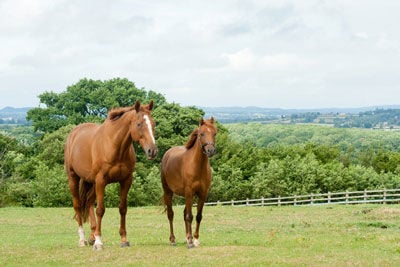
Horses under 3 and those who are inactive were found to be particularly at risk
Other risk factors included horses out grazing full time in a humid environment, especially where dead leaves had piled up in autumn; the presence of Sycamore trees and/or woods near grazing fields; and hay being fed from the ground during autumn months. Interestingly, out of the 14 countries data was collected from for the study, the U.K. had third highest number of cases, after France and Belgium.
Symptoms
Unfortunately, Atypical Myopathy has a high mortality rate of 74% (Votion et al. 2020), with horses often succumbing to the illness within 2 – 3 days (Bates, 2022). However, another study conducted in 2020 by Dunkel et al. found that the mortality rate dropped to 54% in horses that were quickly hospitalised. Therefore, being aware of the symptoms of Atypical Myopathyis vital so that your vet can be contacted as soon as possible and treatment started at the earliest convenience.
Symptoms of Atypical myopathy include -
- Sudden onset of muscle weakness and stiffness (Bochnia et al. 2015)
- Muscle tremors (Votion & Serteyn, 2008)
- Loss of ability to stand (Brandt et al. 1997)
- Depression, often accompanied by low hanging head (Votion & Serteyn, 2008)
- Difficulty in breathing (Gonzalez-Medina et al. 2017)
- Abnormal cardiac changes (Verheyen et al. 2012)
- Dark/red coloured urine (Votion & Serteyn, 2008)
- Colic like symptoms
Although physical symptoms are mainly used for a diagnosis there are some tests your vet can conduct if Atypical Myopathyis suspected. These include;
- Checking electrolyte balance (Votion, 2012)
- Checking lactate dehydrogenase (LDH) and creatine kinase (CK) levels which indicate muscle damage (Bochnia et al. 2015)
- Checking blood and urine samples as the Hypoglycin A toxin can be found in these samples (Votion, 2012)
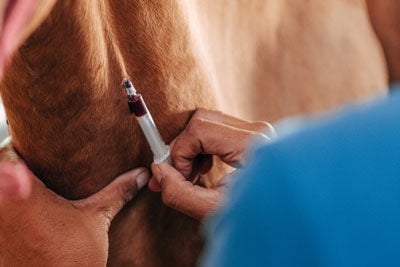
Hypoglycin A can be found in the horse's blood if poisoning has occurred
Prevention
Due to the high mortality rate and the absence of specific treatment, prevention is the key to avoiding Atypical Myopathy (Votion et al. 2020; Bates, 2022).
Depending on weather conditions the sycamore (helicopter) seeds have been shown to travel several hundred meters (Katul et al. 2005) so even if your field is not near any sycamore trees it is important to still be vigilant for the seeds in autumn and seedling which grow in spring. If your grazing is near sycamore trees and the presence of seeds or seedlings is abundant it is advised to stop grazing on the affected area.
In studies conducted by both González-Medina et al. (2017) and Votion et al. (2020) horses grazing for more than six hours per day were seen to be at an increased risk of AM. This suggests that the length of exposure to the toxins is a determining factor and reducing turnout during at risk times of year may help to reduce the risk of the disease, although this method should not be relied upon.
Receiving supplementary forage (hay and straw) throughout the year has been shown to decrease the risk of Atypical myopathy (Votion et al. 2009), however feeding hay from the ground has been shown to be a risk factor (Votion et al. 2020). This indicates that hay fed on the ground can increase the risk of ingesting sycamore seeds and seedlings, so it is ideal to feed from haynets or raised hay feeders. If hay feeders are used ensure these are cleaned out regularly in case any seeds have found their way into the feeder.
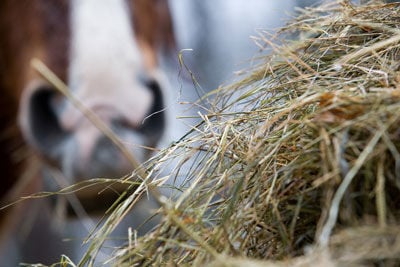
Feeding hay or straw throughout the year has been shown to decrease the risk of AM
Seedlings should be removed from pasture when seen, ideally removing all roots (Votion et al. 2020). Mowing is often recommended as a method of controlling seedlings, however a study conducted by González‐Medina et al. (2019) found that there was no significant decline in Hypoglycin A (HGA), content in mowed seedlings. After one-week HGA concentration increased in grass cuttings that contained seedlings. Therefore, if using mowing as a method to remove seedlings from pasture it is vital that the mowed cuttings are removed from the pasture before horses are allowed to graze the area.
Other prevention methods
The spreading of manure and harrowing of pastures has been shown to increase the risk of Atypical myopathy(Votion et al. 2009). This practice is likely to increase the risk of the dispersal of the seeds throughout the pasture. It is therefore advised to avoid these practices during at risk times of year.
Hypoglycin A is a water-soluble toxin that may pass from plants to water by if seeds, seedlings or leaves end up in the water (Votion et al. 2019). This may explain why a humid environment increases the risk of AM, and also why it is advised that only pastures that do not contain rivers or freestanding water should be used during the risky seasons.
PLEASE NOTE: You should contact your vet immediately if you suspect your horse has eaten sycamore seeds, seedlings or leaves, especially as the disease progresses rapidly and has a high mortality rate.
Treatment
There is no specific treatment for horses diagnosed with Atypical myopathy (Votion, 2012), and treatment is mainly supportive aiming to increase survival rates (Fabius & Westermann, 2018). According to Fabius & Westermann (2018) treatment options include;
- Resolving dehydration and electrolyte imbalances
- Providing energy for affected muscles
- Eliminating toxins in the body
- Providing pain relief
- Prevent further intoxication and injury
For any advice or questions you may have, please don't hestiate to reach out to our expert nutrition team. You can call 0800 585525 Monday-Friday 8:30am-5:00pm. Email [email protected], or send us a DM on social media.
References
Bates, N. (2022) ‘Atypical myopathy.’, UK-Vet Equine, 6(3), pages 96-102.
Bochnia, M., Ziegler, J., Sander, J., Uhlig, A., Schaefer, S., Vollstedt, S., Glatter, M., Abel, S., Recknagel, S., Schusser, G. F., Wensch-Dorendorf, M., & Zeyner, A. (2015) ‘Hypoglycin a content in blood and urine discriminates horses with atypical Myopathy from clinically normal horses grazing on the same pasture.’, PLoS ONE, 10(9), pages 1-15
Brandt, K., Hinrichs, U., Glitz, F., Landes, E., Schulze, C., Deegen, E., Pohlenz, J., & Coenen, M. (1997) ‘Atypische myoglobinurie der weidepferde.’, Pferdeheilkunde, 13(1), pages 27-34.
Dunkel, B., Ryan, A., Haggett, E. and Knowles, E.J. (2020) ‘Atypical myopathy in the South‐East of England: Clinicopathological data and outcome in hospitalised horses.’, Equine Veterinary Education, 32(2), pages 90-95.
Fabius, L. S., & Westermann, C. M. (2018) ‘Evidence-based therapy for atypical myopathy in horses.’, Equine Veterinary Education, 30(11), pages 616-622.
Fagan, M. M., Pazdro, R., Call, J. A., Abrams, A., Harris, P., Krotky, A. D., & Duberstein, K. J. (2017) ‘Assessment of oxidative stress and muscle damage in exercising horses in response to level and form of vitamin E.’, Journal of Equine Veterinary Science, 52, pages 80-81.
Finno, C. J., Valberg, S. J., Wünschmann, A., & Murphy, M. J. (2006) ‘Seasonal pasture myopathy in horses in the midwestern United States: 14 Cases (1998-2005).’, Journal of the American Veterinary Medical Association, 229(7), pages 1134-1141
González-Medina, S., Ireland, J. L., Piercy, R. J., Newton, J. R., & Votion, D. M. (2017). ‘Equine atypical myopathy in the UK: Epidemiological characteristics of cases reported from 2011 to 2015 and factors associated with survival.’, Equine Veterinary Journal, 49(6), pages 746-752.
Katul, G.G.; Porporato, A.; Nathan, R.; Siqueira, M.; Soons, M.B.; Poggi, D.; Horn, H.S.; Levin, S.A. (2005) ‘Mechanistic analytical models for long-distance seed dispersal by wind.’, American Naturalist., 166, pages 368–381.
Kranenburg, L. C., Westermann, C. M., de Sain-van der Velden, M. G. M., de Graaf-Roelfsema, E., Buyse, J., Janssens, G. P. J., van den Broek, J., & van der Kolk, J. H. (2014). ‘The effect of long-term oral L-carnitine administration on insulin sensitivity, glucose disposal, plasma concentrations of leptin and acylcarnitines, and urinary acylcarnitine excretion in warmblood horses.’, Veterinary Quarterly, 34(2), pages 85-91.
Unger, L., Nicholson, A., Jewitt, E. M., Gerber, V., Hegeman, A., Sweetman, L., & Valberg, S. (2014). Hypoglycin A Concentrations in Seeds of Acer Pseudoplatanus Trees Growing on Atypical Myopathy-Affected and Control Pastures. Journal of Veterinary Internal Medicine, 28(4): 1289-1293.
van Galen, G., Marcillaud Pitel, C., Saegerman, C., Patarin, F., Amory, H., Baily, J. D., Cassart, D., Gerber, V., Hahn, C., Harris, P., Keen, J. A., Kirschvink, N., Lefere, L., Mcgorum, B., Muller, J. M. V., Picavet, M. T. J. E., Piercy, R. J., Roscher, K., Serteyn, D., Votion, D. M. (2012). European outbreaks of atypical myopathy in grazing equids (2006-2009): Spatiotemporal distribution, history and clinical features. Equine Veterinary Journal, 44(5): 614-620.
Verheyen, T., Decloedt, A., de Clercq, D., & van Loon, G. (2012). ‘Cardiac Changes in Horses with Atypical Myopathy.’, Journal of Veterinary Internal Medicine, 26(4), pages 1019-1026.
Votion, D. M., & Serteyn, D. (2008). ‘Equine atypical myopathy: A review.’, Veterinary Journal, 178(2), pages 185–190.
Votion, D. M., Linden, A., Delguste, C., Amory, H., Thiry, E., Engels, P., van Galen, G., Navet, R., Sluse, F., Serteyn, D., & Saegerman, C. (2009). Atypical myopathy in grazing horses: A first exploratory data analysis. Veterinary Journal, 180(1): 77-87.
Votion, D. M. (2012). The Story of Equine Atypical Myopathy: A Review from the Beginning to a Possible End. ISRN Veterinary Science, 2012: 1–14
Votion, D.M.; Habyarimana, J.A.; Scippo, M.L.; Richard, E.A.; Marcillaud-Pitel, C.; Erpicum, M.; Gustin, P. (2019) ‘Potential new sources of hypoglycin A poisoning for equids kept at pasture in spring: A field pilot study.’, Veterinary Record, 184, page 740
Votion, D.M., François, A.C., Kruse, C., Renaud, B., Farinelle, A., Bouquieaux, M.C., Marcillaud-Pitel, C. and Gustin, P. (2020) ‘Answers to the frequently asked questions regarding horse feeding and management practices to reduce the risk of atypical myopathy.’, Animals, 10(2), page 365.
Westermann, C. M., van Leeuwen, R., van Raamsdonk, L. W. D., & Mol, H. G. J. (2016). ‘Hypoglycin A Concentrations in Maple Tree Species in the Netherlands and the Occurrence of Atypical Myopathy in Horses.’, Journal of Veterinary Internal Medicine, 30(3), pages 880-884.
Żuraw, A., Dietert, K., Kühnel, S., Sander, J., & Klopfleisch, R. (2016). ‘Equine atypical myopathy caused by hypoglycin A intoxication associated with ingestion of sycamore maple tree seeds.’, Equine Veterinary Journal, 48(4), pages 418-421.

